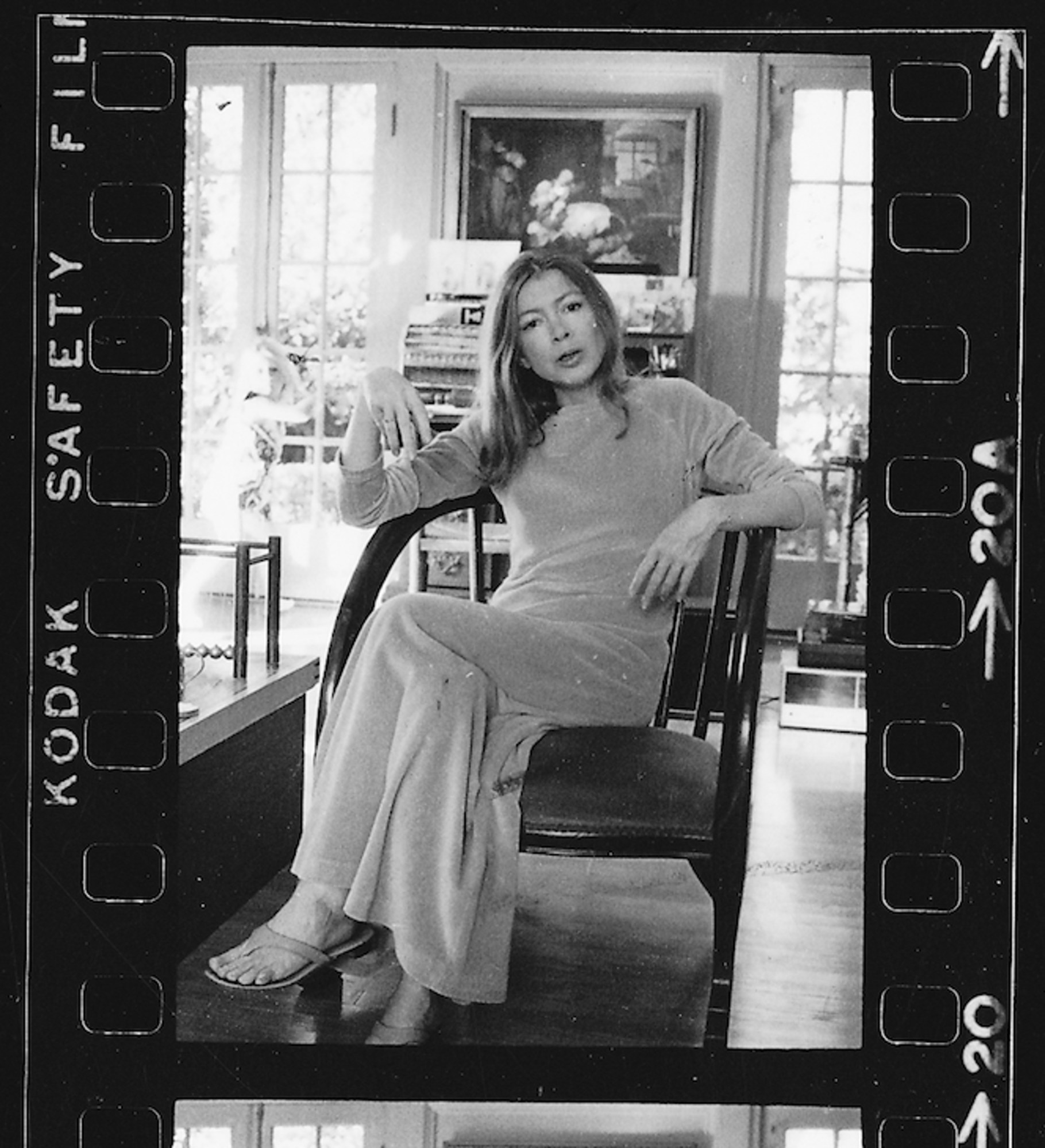Joan Didion makes cucumber sandwiches with precision. She picks apart a sprig of basil leaf by tiny leaf. She slowly, decisively slices the crusts off the white bread. She is standing in her kitchen, somewhere near Central Park, in a beige wool sleeveless sweater that reveals very thin arms. Watching this on screen, I was worried that she might drop the knife. Behind her is a fridge so large it feels almost comically symbolic of her family’s attempts to keep her fed.
Joan is 82 and her neatly petite self is very present in Joan Didion: The Center Will Not Hold, a new documentary about her life directed by her nephew, Griffin Dunne. Her frame seems in direct opposition to her literary weight; she is a pioneer of New Journalism, one of America’s most important writers. When we watch Dunne’s footage of Joan accepting the National Medal of Arts and Humanities from Obama in 2013, this contrast feels particularly clear. An Atlantic article about the event described the medal as being “as big as she is.” (Joan, in the documentary, points out that she has maintained the same weight since the 70s.)
Looking at Joan, it’s hard not to think about her mystique. She has been studied for decades, at least since she published her era-defining first essay collection, Slouching Towards Bethlehem in 1968. Her outfits, habits, mannerisms, and diet have been pored over and emulated by fans who only partially overlap with her legions of readers. When Phoebe Philo included Didion in her spring/summer 15 campaign for Céline (pitch-black glasses, black sweater, Juergen Teller flash), it canonized Joan as the patron saint of fashionable intellectual women, many of whom had idolized both her literary and sartorial styles since her iconic 1961 Vogue essay, “On Self-Respect.”
The Center Will Not Hold provides new details for devoted students of Joan. In one interview, a friend remembers staying with Didion, and her late husband John Gregory Dunne, at their romantically large house in 70s Hollywood. She describes how Joan would come downstairs late each morning in dark sunglasses, and sit in silence at the breakfast table drinking a refrigerated Coke and eating only almonds. A different friend (there is a great cast of talking heads) remembers that at dinner parties during Joan and John’s years in Malibu, Warren Beatty would always request to sit next to Joan because he had a crush on her. We learn that present-day Joan is, surprisingly, a fan of ice cream.
My favorite discovery was that Harrison Ford worked on Joan and John’s (huge, sea-facing) Malibu terrace when he was just young carpenter Harrison Ford. Dunne also enjoys this detail, since he was around the house in Malibu that summer. “Harrison was my idol when I was 15,” he explains to me, “I smoked cigarettes with him. The way he would tear the filters off Marlboros was the coolest thing I had ever seen.” In the documentary, Ford explains how Joan and John would always invite him to their parties, though he felt he wasn’t as smart as their high-profile guests, who included Steven Spielberg, Natalie Wood, and Martin Scorsese. (“It was a very hot time,” another friend remembers of Didion’s Malibu parties, “not as in sex, but creatively.”)
For Dunne, the most interesting revelation was that Joan will put a manuscript in her freezer when she no longer feels like working on it. “It’s very much about her character, the kind of woman she is” he says, “She doesn’t rush, she gets to things when she’s ready.”
Dunne decided to make the documentary when he realized that no one else had made one. “It felt as much a duty as a creative expression,” he says. He launched a Kickstarter campaign in 2014, with the goal of raising $80,000 to cover production costs. He met that goal within 24 hours and eventually raised over $220,000. “Joan was a chronicler of her times, and that world is quickly disappearing,” Dunne wrote on the campaign page.
One of his hopes for the film, which arrives on Netflix on October 27, is that it demonstrates the perceptiveness of Didion’s writing, and how much the events she chronicled resemble those of our present. “Her writing tends to have an unintended but prophetic quality,” Dunne says. He points out how acute her analysis of the Central Park jogger case was, and the film includes extracts of her ever-relevant description of America’s racial divide alongside Trump’s infamous 1989 racist rant (“maybe hate is what we need”). Didion knew an idiot when she saw one, and was never afraid to say so.
The film is also deeply personal. Dunne appears on camera several times, emerging in Didion’s apartment to ask his aunt questions. “Being related to her was both the good and bad news” about making the film, he says. He included home video footage of the Didion-Dunne family and of course had great access. But Dunne also had to revisit painful moments from his own family history, while prompting Joan to discuss them. “It was not fun at all,” he says, “I had to ask her to relive this. Emotionally, it was pretty overwhelming for her.”
Joan initially consented to the project by saying, “Oh, ok,” Dunne remembers. Later, she confirmed over email that she couldn’t come up with a compelling enough reason to say no. But Dunne could never get her to discuss the cult of Joan Didion. “You’d have to torture her to speak about that, and she still probably won’t.”
“But,” he adds, “She’s not oblivious to where she sits in the world.”
“Joan Didion: The Center Will Not Hold” is in theaters and on Netflix from Friday, October 27.
